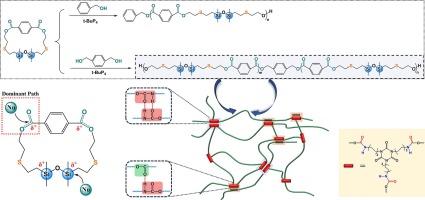Studies on preparation of silicon-containing polyester via ring-opening polymerization and new type of elastomers derived from the resulting diols
IF 5.8
2区 化学
Q1 POLYMER SCIENCE
引用次数: 0
Abstract
Silicon-containing polyesters represent a novel class of polymers that integrate silicone and polyester units within their main chain. Polysiloxanes typically consist of flexible chain segments, while polyesters are characterized by their rigidity. The combination of these two components in the main chain offers the potential for tunable properties across a broad range. For the first time, a new organosilicon cyclic ester monomer (Si-Mon) was synthesized using a pseudo-high dilution condensation method. Both theoretical and experimental studies confirm that the ring-opening reaction site of Si-Mon is the ester group, rather than the Si-O-Si bond. Silicon-containing polyesters (SiPET-Series 1) with molecular weights exceeding 20,000 Da were efficiently and rapidly synthesized at room temperature, utilizing benzyl alcohol as the initiator and t-BuP4 as the catalyst. Organosilicon polyester diols (SiPET-Series 2) with varying molecular weights were produced using 1,4-benzenedimethanol as the initiator. Additionally, a new type of organosilicon polyester elastomer (SiPET-E) was developed by employing SiPET-Series 2 as the base gum and (2,4,6-trioxotriazine-1,3,5(2H,4H,6H)- triyl)tris(hexamethylene)isocyanate (THDI) as the crosslinking agent. The stress–strain behavior of SiPET-E is influenced by the molecular weight of SiPET-Series 2. Notably, SiPET-E exhibits remarkable properties; for instance, it demonstrates superelastic characteristics when the molecular weight of SiPET-Series 2 is 13,000 g/mol, achieving a tensile strength of 2.56 MPa and an elongation at break of 776 % without the use of reinforcing fillers.

通过开环聚合法制备含硅聚酯以及由所得二元醇衍生出的新型弹性体的研究
含硅聚酯是一类新型聚合物,其主链中集成了硅氧烷和聚酯单元。聚硅氧烷通常由柔性链段组成,而聚酯则以刚性为特征。主链中这两种成分的结合为实现广泛的可调特性提供了可能。我们首次采用假高稀释缩合法合成了一种新型有机硅环酯单体(Si-Mon)。理论和实验研究都证实,Si-Mon 的开环反应位点是酯基,而不是 Si-O-Si 键。利用苯甲醇作为引发剂,t-BuP4 作为催化剂,在室温下高效、快速地合成了分子量超过 20,000 Da 的含硅聚酯(SiPET-系列 1)。使用 1,4-苯二甲醇作为引发剂,生产出了不同分子量的有机硅聚酯二元醇(SiPET 系列 2)。此外,以 SiPET 系列 2 为基胶,以(2,4,6-三氧三嗪-1,3,5(2H,4H,6H)-三基)三(六亚甲基)异氰酸酯 (THDI) 为交联剂,开发了一种新型有机硅聚酯弹性体 (SiPET-E)。SiPET-E 的应力应变行为受 SiPET-Series 2 分子量的影响。值得注意的是,SiPET-E 具有显著的特性,例如,当 SiPET-Series 2 的分子量为 13,000 g/mol 时,它表现出超弹性特性,在不使用增强填料的情况下,拉伸强度达到 2.56 MPa,断裂伸长率达到 776%。
本文章由计算机程序翻译,如有差异,请以英文原文为准。
求助全文
约1分钟内获得全文
求助全文
来源期刊

European Polymer Journal
化学-高分子科学
CiteScore
9.90
自引率
10.00%
发文量
691
审稿时长
23 days
期刊介绍:
European Polymer Journal is dedicated to publishing work on fundamental and applied polymer chemistry and macromolecular materials. The journal covers all aspects of polymer synthesis, including polymerization mechanisms and chemical functional transformations, with a focus on novel polymers and the relationships between molecular structure and polymer properties. In addition, we welcome submissions on bio-based or renewable polymers, stimuli-responsive systems and polymer bio-hybrids. European Polymer Journal also publishes research on the biomedical application of polymers, including drug delivery and regenerative medicine. The main scope is covered but not limited to the following core research areas:
Polymer synthesis and functionalization
• Novel synthetic routes for polymerization, functional modification, controlled/living polymerization and precision polymers.
Stimuli-responsive polymers
• Including shape memory and self-healing polymers.
Supramolecular polymers and self-assembly
• Molecular recognition and higher order polymer structures.
Renewable and sustainable polymers
• Bio-based, biodegradable and anti-microbial polymers and polymeric bio-nanocomposites.
Polymers at interfaces and surfaces
• Chemistry and engineering of surfaces with biological relevance, including patterning, antifouling polymers and polymers for membrane applications.
Biomedical applications and nanomedicine
• Polymers for regenerative medicine, drug delivery molecular release and gene therapy
The scope of European Polymer Journal no longer includes Polymer Physics.
文献相关原料
公司名称
产品信息
阿拉丁
1,4-benzenedimethanol
阿拉丁
benzyl alcohol
阿拉丁
2-mercaptoethanol (β-ME)
阿拉丁
2,2-dimethoxy-2-phenylacetophenone (DMPA)
阿拉丁
1,4-diazabicyclo[2.2.2]octane (DABCO)
阿拉丁
terephthaloyl chloride
 求助内容:
求助内容: 应助结果提醒方式:
应助结果提醒方式:


